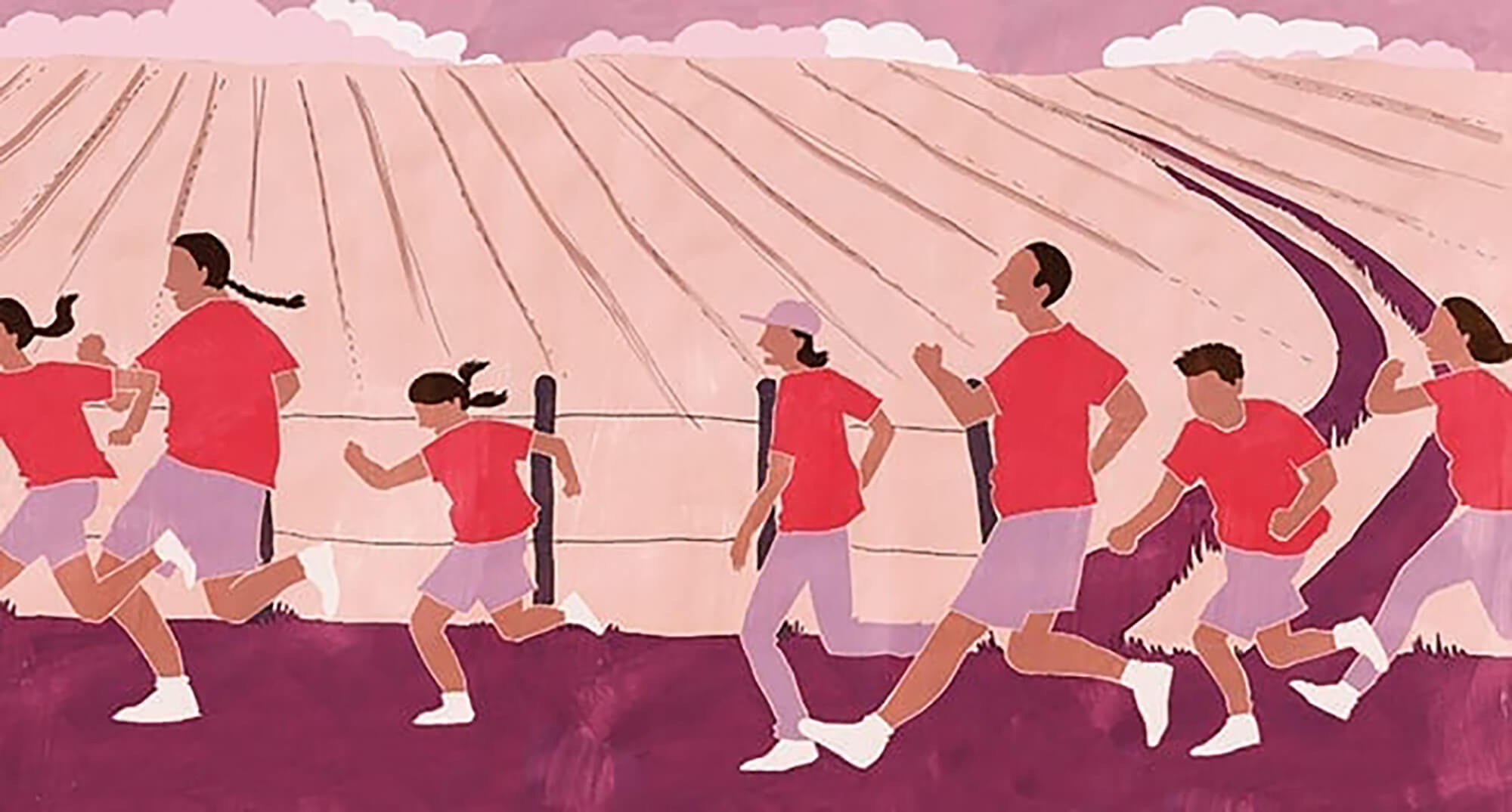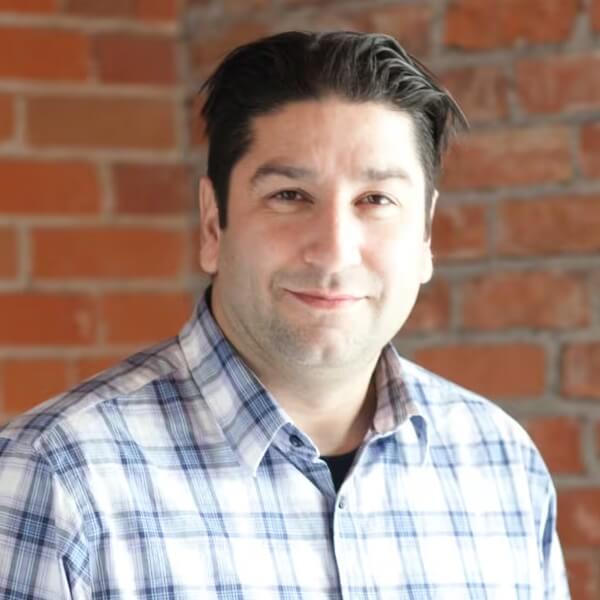The Red Worn Runners: Intentional Conversations with Indigenous Youth
Sometimes five, sometimes 18, one time 30, but every day through August the Red Worn Runners have been inspiring me as we shuffle, sprint, and navigate our way down the dusty roads of Enoch Cree Nation, always wearing red – red T-shirts that is. It is a beautiful thing to experience. We always start at the local school in the town site, stretching, slowly getting ready for a run. Sometimes I love this daily ritual, other times I loathe it; it depends how my body is feeling. But we stick together through this, one day at a time. …
We are all in a line, a long red line, staying as close together as possible. And when the Red Worn Runners take off into the distance, it is magical. It takes me home every time we run; home to the gravel roads and the farms of my youth, to the wheat fields and barley fields, and the beautiful sounds and smells that I cannot imagine in the city. We talk about treaties, families, relationships, and the beauty of creation on the morning jogs. We are simply moving knowledge, as Basso might say. This is the living curriculum they talk about, the familial curriculum acknowledged. I did not think that the kids would continue but it goes to show you how much I don’t know. They showed up every day and even run on their own these days.
The Red Worn Runners will continue to be on my mind as the leaves get ready to turn and the farmer swaths down the majesty to the left and the flowering yellow to the right. It is indeed a beautiful thing, one I won’t soon forget. …
Many years later I continue to go back to this opening narrative, at times reading it, at times sharing it with different audiences, but always pausing somewhere in the middle and thinking with these earlier moments of teaching. I reread this narrative today, letting my words call those youth back to mind. Letting the words take me back to their words, their stories, their voices and the images of moving in a different way alongside one another. Letting the words take me back to the dreams of what might be possible if we listen carefully and attend to the voices of Indigenous youth. These words stay with me as I think of who I am and who I am becoming as an Indigenous writer and educator. They remind me to always return to the early experiences, sometimes physically, sometimes metaphorically, for it is in that return home that I am sustained.
Creating Conversational Spaces
… I was teaching Social Studies at a large urban high school in a prairie city. I was given an opportunity by school leadership, particularly the principal, to create and lead an initiative aimed at meeting district and provincial goals of increasing high school completion and retention for Indigenous students. Through this process I was given one spare period to start meeting individually with the 250 self-identified First Nation, Métis, and Inuit (FMNI) students who were enrolled in this school.
“I want to graduate.”
“The fact that I am Aboriginal tells me that most people won’t think I will make it, but I know I will.”
“I want to be as highly respected as my late grandfather someday.”
“We want to make our grandmother proud.”
Their words reverberate in my thoughts, even now, as I sift through vision statements we created many years ago. Through those intentional conversations, the youth and I co-created spaces within a high school in which I came to better understand, and respond to, what mattered in the lives of Indigenous youth attending this school.
Moving With Intention
The youth taught me, through this work and through this in-between space of intentional conversation on a school landscape, to move with intention, both metaphorically and physically.
To move with intention in this way means to be responsive in the ways in which I am trying to understand the experiences of youth within the context of school. It is expressed through my actions and responses to the voices of youth and the calls that they were making – both directly and indirectly – to engage in something different. More broadly, it is a call to move beyond rhetoric in student voice, and in particular Indigenous student voice within the institution of school.
The title of the opening narrative, The Red Worn Runners, was a name the youth chose for themselves. These young Indigenous people wanted to engage in education differently. They were determined to graduate from high school with their classmates. However, they were unable to participate in summer school courses in the high school due to transportation and jurisdictional issues between federal and provincial school systems.
As I created a conversational space and invited each of those 250 students, one by one, into conversation with me, they began to feel that their voices were being heard and honoured with a response. In these conversations the youth shared their hopes and dreams for their futures. They shared their hopes of graduating with their peers, which required taking specific summer courses to fulfill their dreams. As I heard their voices and recalled my own experiences as a youth, I began to imagine how this might be possible. As I talked with the students, initially there were four or five students interested in summer school studies. By the time summer school started that July, there were over 30.
“We are all in a line, a long red line, staying as close together as possible.”
Embracing Uncertainty
I quickly recruited teacher colleagues who were open, flexible, and willing to try something different. We proposed to teach Math, Social Studies, Aboriginal Studies, and Career and Life Management during the summer months. No longer would we as teachers be living within the comfort of classroom subjects and the familiarity of our classroom and school environment in the city. The classroom would be located in the youth’s home-place of Enoch Cree Nation, a community with distinct protocols and teachings that are layered in the history of the land and people. This summer school experience would be markedly different for the teachers and for the students, their families, and their community.
The students would be our guides and in many ways our teachers. Their voices would lead the way and their everyday actions and movements would shape daily programming.
All along they were teaching us, as teachers, new steps, new rhythms to our knowing of teaching.
As teachers we had to learn to let go of the certainty of what we knew from teaching within school. We would learn through this experience to improvise and let go of what we could no longer guarantee as certain or comfortable.
As we began to plan with the students and to travel to the community, we – students and teachers – were learning and imagining school differently. We were learning and imagining alongside one another in this work. Time looked different in the company of trees and through “the wheat fields and barley fields, and the beautiful sounds and smells that I(we) cannot imagine in the city.”
Looking Backwards and Forward
Our school colour was red, and as we met each morning during the summer months, the youth wanted to begin each day with a run. They chose the colour red as it was a noticeable colour when we were running on the gravel roads of Enoch Cree Nation. The youth spoke of the importance of being visible through their actions. All along they were teaching us, as teachers, new steps, new rhythms to our knowing of teaching.
Now, many years later, I reflect on how time has moved quickly and now the Red Worn Runners have moved on in different directions and trajectories in their lives. Many of the youth have now graduated from college and university. Some are teachers while others are excelling in various professions and careers. I too have moved on to a different position at a university, but those days of learning alongside the Red Worn Runners stay with me in the present. They taught me. They took me home to what it means to be a youth, an Indigenous youth, in high school and what might happen if teachers and others listened carefully to students and together imagined what might be possible within schools.
I chose to highlight various threads in this article – creating conversational spaces, moving with intention, and embracing uncertainty – as examples of what stood out to me as I reflected on the experience and what I have learned about the importance of student voice and response to student voice. I recognize that it would not be appropriate or realistic that every classroom and school participate in a similar way to the one I shared; that would be a misreading of my intentions. However, to me the sharing of this narrative was never about the specific programming details of a summer school experience alongside Indigenous youth.
I tell this story now to show how much the young people within the Red Worn Runners pushed me as well as my colleagues to move differently, to think differently, and to embrace what might happen when youth lead, not only with their voices but through their actions… through their movements.
Dr. Sean Lessard is Woodland Cree from Montreal Lake Cree Nation in Northern Saskatchewan. Sean is currently a Professor at the University of Alberta, specializing in Indigenous Education, working alongside and relentlessly advocating, researching, and writing about the experiences of Indigenous youth and families, both inside and outside of educational spaces.
Illustration by Melanie Luther.
Adapted from the full article that first appeared in EdCan Network on December 7, 2016.


